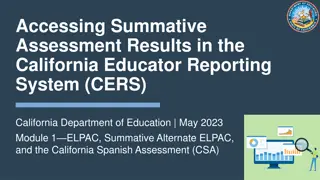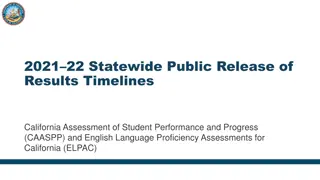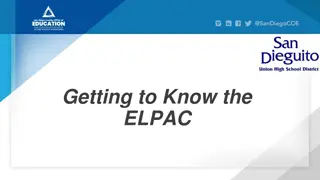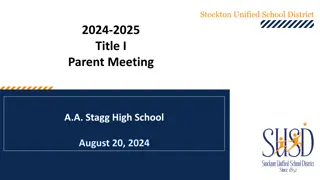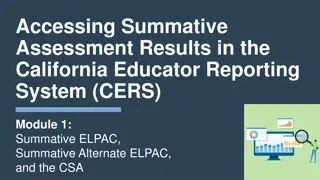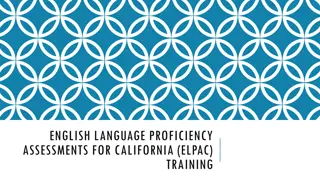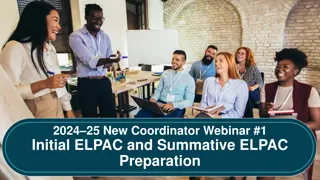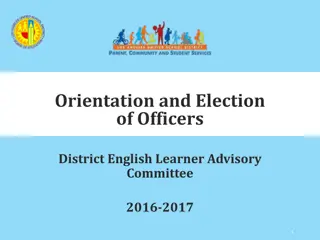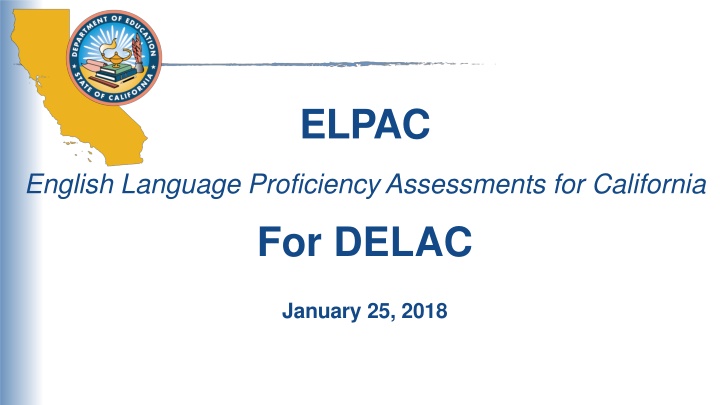
Understanding ELPAC and CELDT Assessments for English Learners in California
Explore the differences between the Annual CELDT and Summative ELPAC assessments, assessment windows, grade spans, test formats, and performance levels. Gain insights into the English Language Proficiency Assessments for California and the educational requirements to support English Learners in acquiring language proficiency and grade-level content knowledge.
Download Presentation

Please find below an Image/Link to download the presentation.
The content on the website is provided AS IS for your information and personal use only. It may not be sold, licensed, or shared on other websites without obtaining consent from the author. If you encounter any issues during the download, it is possible that the publisher has removed the file from their server.
You are allowed to download the files provided on this website for personal or commercial use, subject to the condition that they are used lawfully. All files are the property of their respective owners.
The content on the website is provided AS IS for your information and personal use only. It may not be sold, licensed, or shared on other websites without obtaining consent from the author.
E N D
Presentation Transcript
ELPAC English Language ProficiencyAssessments for California For DELAC January 25, 2018
English Learner Law Under Title VI of the Civil Rights Act of 1964 and the Equal Education Opportunity Act, California must: identify and assess ELs upon enrollment Initial monitor and evaluate EL students to ensure their progress with respect to acquiring English proficiency and grade level content knowledge. Summative
Annual CELDT versus Summative ELPAC CELDT ELPAC Aligned with 2012 ELD Standards Aligned with 2012 ELD Standards One test two purposes; initial assessment annual assessment Domains assessed: Listening, Speaking, Reading and Writing Two separate tests; initial assessment (IA) summative assessment (SA). Domains assessed: Listening, Speaking, Reading and Writing
Annual CELDT versus Summative ELPAC CELDT ELPAC Assessment Window July 1 Oct 31 Assessment Window Feb 1 May 31 Seven grades/grade spans: K*, 1, 2, 3 5, 6 8, 9 10, and 11 12 Five grades/grade spans: K 1*, 2, 3 5, 6 8, 9 12 Paper-pencil tests Paper-pencil tests Performance levels: Five Performance levels: Four Listening test items were read by the Test Examiner Listening test items in grades 3 12 are recordings that are played *TK is tested on K assessment
Sib Txuas Lus Tawm Tswv Yim Let s Talk: Step 1: With a partner, discuss the most important idea from the comparison between the CELDT and the ELPAC Questions or concerns you still have
ELPAC Score Information-Summative Overall Score 4 Performance Levels Oral Language Scale Score 4 Performance Levels Written Language Scale Score 4 Performance Levels Speaking 3 Performance Levels Reading 3 Performance Levels Writing Listening 3 Performance Levels 3 Performance Levels
ELPAC General Performance Level Descriptors English learners at this level have well developed oral (listeningand speaking) and written (readingand writing)skills. Theycan use English to learn and communicate in meaningfulways thatare appropriateto differenttasks, purposes,and audiences in a varietyof social and academic contexts.They may need occasional linguisticsupportto engage in familiar social and academic contexts; theymay need light supportto communicate on less familiar tasks and topics. This test performancelevel correspondsto theupperrange of the Bridging proficiencylevel as describedin the 2012 CaliforniaEnglish LanguageDevelopmentStandards:KindergartenThroughGrade 12 (CA ELD Standards). Level 4 English learners at this level have moderatelydeveloped oral (listeningand speaking) and written(readingand writing)skills. Theycan sometimes use English to learn and communicate in meaningfulways in a range of topics and content areas. They need lightto minimal linguisticsupportto engage in familiar social and academic contexts; theyneed moderatesupportto communicate on less familiar tasks and topics. This test performancelevel correspon Bridging proficiencylevel as described in theCA ELD Standards. Level 3 ds to theupperrange of the Expanding proficiencylevel throughthelower rangeof the English learners at this level have somewhat dev English to meet immediate communication needs areas. They need moderate-to-lightlinguisticsupp supportto communicate on less familiar tasks and Expanding proficiencylevel as describedin the eloped oral (listeningand speaking) and written (readingand writing)skills. Theycan use butoften are not able to use English to learn and communicate on topics and content ortto engage in familiar social and academic contexts; theyneed substantial-to-moderate topics. This test performancelevel correspondsto the low- to mid-rangeof the CA ELD Standards. Level 2 English learners at this level have minimally devel tend to rely on learned words and phrases to com to communicate in familiar social and academic c topics. This test performancelevel correspondsto oped oral (listeningand speaking) and written(readingand writing) English skills. They municate meaning at a basic level. Theyneed substantial-to-moderatelinguisticsupport ontexts; theyneed substantiallinguisticsupportto communicate on less familiar tasks and the Emerging proficiencylevel as describedin the CA ELD Standards. Level 1
Connecting the ELPAC Levels to the 2012 ELD Standards ELD Standards ELD Standard Level ELPAC Level
Additional Key Points There will NOT be a comparison between the Initial Assessment and the SummativeAssessment. They are two different assessments with two different purposes. Threshold scores go before the State Board of Education for approval.

